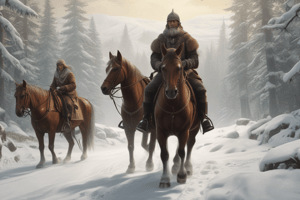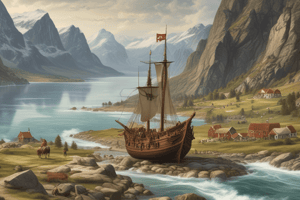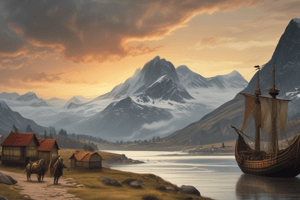Podcast
Questions and Answers
What was a significant political change established in Norway in 1884?
What was a significant political change established in Norway in 1884?
- Norway joined the European Union
- The monarchy was abolished
- Norway became a republic
- Parliamentarism was established (correct)
Which of the following events occurred in 1905 in Norway?
Which of the following events occurred in 1905 in Norway?
- The union with Sweden was dissolved (correct)
- Norway joined NATO
- The first polar expedition was completed
- Oil was discovered
What was one of the main economic sectors contributing to Norway's wealth after oil discovery?
What was one of the main economic sectors contributing to Norway's wealth after oil discovery?
- Manufacturing
- Oil and gas production (correct)
- Tourism
- Agriculture
What major international alliance did Norway join after World War II?
What major international alliance did Norway join after World War II?
What was a significant economic challenge Norway faced in the late 1980s?
What was a significant economic challenge Norway faced in the late 1980s?
What dietary staples did the earliest inhabitants of Norway primarily rely on?
What dietary staples did the earliest inhabitants of Norway primarily rely on?
When did the Neolithic period begin in Norway?
When did the Neolithic period begin in Norway?
During which period were hilltop forts constructed in Norway?
During which period were hilltop forts constructed in Norway?
What major event halved the population of Norway around 1349?
What major event halved the population of Norway around 1349?
What significant political change happened in Norway in 1814?
What significant political change happened in Norway in 1814?
Which treaty ceded Norway to the king of Sweden?
Which treaty ceded Norway to the king of Sweden?
What was a direct result of the Reformation in Norway in 1537?
What was a direct result of the Reformation in Norway in 1537?
In what decade did industrialization begin in Norway?
In what decade did industrialization begin in Norway?
Flashcards
Viking Age
Viking Age
The period in Norway's history when Vikings were prominent, marked by seafaring, trade, and raids.
Black Death
Black Death
A drastic reduction in the Norwegian population in the 14th century caused by outbreaks of a deadly disease.
Kalmar Union
Kalmar Union
The 14th century union between Norway, Denmark, and Sweden.
Reformation in Norway
Reformation in Norway
Signup and view all the flashcards
Denmark–Norway (1523-1814)
Denmark–Norway (1523-1814)
Signup and view all the flashcards
1814 Norwegian Constitution
1814 Norwegian Constitution
Signup and view all the flashcards
Union with Sweden
Union with Sweden
Signup and view all the flashcards
Industrialization in Norway
Industrialization in Norway
Signup and view all the flashcards
Parliamentarism in Norway
Parliamentarism in Norway
Signup and view all the flashcards
Dissolution of the Union with Sweden
Dissolution of the Union with Sweden
Signup and view all the flashcards
Economic Growth in Early 20th Century Norway
Economic Growth in Early 20th Century Norway
Signup and view all the flashcards
German Occupation of Norway
German Occupation of Norway
Signup and view all the flashcards
Oil Discovery and its Impact on Norway
Oil Discovery and its Impact on Norway
Signup and view all the flashcards
Study Notes
Early Norway: Influence of Terrain and Climate
- Early inhabitants migrated north along the coast, following the retreat of glaciers, aided by the warming Gulf Stream.
- Hunter-gatherer lifestyle focused on seafood and reindeer.
- Early agricultural settlements appeared around the Oslofjord by 5000-4000 BC and spread southwards.
Neolithic Period to the Viking Age
- Neolithic period began in 4000 BC, leading to chieftain control and hilltop fort construction.
- 8th to 11th Centuries saw Norse expansion across seas to Britain, Iceland, and Greenland.
- Viking Age also saw Norwegian unification.
- Christianization completed in the 11th century, Nidaros becoming an archdiocese.
- Population growth until the Black Death halved the population in 1349. (Oslo: 3,000; Bergen: 7,000; Trondheim: 4,000)
- Bergen became a major trading port controlled by the Hanseatic League.
- Norway joined the Kalmar Union with Denmark and Sweden in 1397.
Union with Denmark & Sweden
- After Sweden's departure in 1523, Norway became a junior partner in Denmark–Norway.
- Reformation introduced in 1537, and absolute monarchy imposed in 1661.
- In 1814, following the Napoleonic Wars, Norway was ceded to the Swedish king by the Treaty of Kiel.
- Norway declared independence, adopted a constitution, but faced Swedish opposition.
- Norway and Sweden subsequently concluded the Convention of Moss, establishing a personal union with Sweden where Norway retained its constitution and institutions, excluding foreign service.
- Union formally ratified and Charles XIII of Sweden became king of Norway.
19th and 20th Centuries
- Industrialization started in the 1840s, followed by large-scale emigration to North America from the 1860s.
- Parliamentarism established in 1884 with Johan Sverdrup appointed prime minister.
- The union with Sweden dissolved in 1905.
- Polar expeditions by figures like Fridtjof Nansen and Roald Amundsen (1880s-1920s).
- Shipping and hydroelectricity were key income sources.
- Fluctuating economy and labor movement growth.
- German occupation (1940-1945), followed by NATO membership and reconstruction under public planning.
- Oil discovery in 1969 made Norway a major exporter, contributing to economic growth.
Modern Norway
• 1980s deregulation, encountering a banking crisis in 1989-1990. • Oil and gas production accounted for 20% of Norway's economy by the 21st century, fostering a large sovereign wealth fund by 2017.
Studying That Suits You
Use AI to generate personalized quizzes and flashcards to suit your learning preferences.




